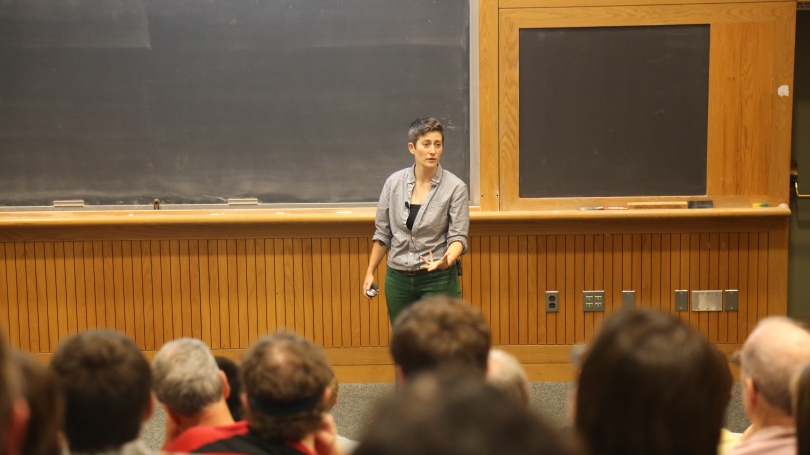
Menu
- Public Policy
- Leadership
- Funding
- News & Events
- About the Center
Back to Top Nav
Back to Top Nav
Back to Top Nav
Back to Top Nav
In honor of 2017 Constitution Day, the Rockefeller Center hosted Professor Moon Duchin of Tufts University, who gave a presentation on the impact of geometry in the determination of voting districts and the larger implications for political representation.
Professor Duchin provided an overview of how congressional districting works and the policy tradeoffs inherent to the current systems of voter counting and apportionment of Congressional representatives. She focused on gerrymandering and its various and often overlapping manifestations: political gerrymandering, which is the redrawing of voting districts for partisan gain; racial gerrymandering, which is the redrawing of voting districts for the purpose of diluting the voting strength of minority groups; and incumbent gerrymandering, which is the redrawing of voting districts for the purpose of creating safe seats for Republican and Democratic politicians. Professor Duchin also explained the different and often complementary mechanisms by which gerrymandering is achieved, specifically, the practices of voter “packing” and voter “cracking.”
From her talk, Duchin’s passion for mathematics and social activism was incredibly evident. In an interview, Duchin discussed the importance of helping others fuse their many interests together just as she has. She also reaffirmed her strong belief in the value of liberal arts and curiosity. Duchin remarked that there is so much to be curious about—a notion that was conveyed as she continued her lecture by focusing on the intersection of traditional districting principles and precedents, past attempts to objectively improve the process of redistricting, and the opportunity modern mathematical principles have to succeed where past endeavors have failed.
Professor Duchin spoke at length about the universal importance of “compactness” in distinguishing good from bad voting districts and contrasted this against the lack of a standard definition and metric of “compactness.” She also explained previous attempts to use measures of isoperimetry, convexity, and dispersion to evaluate the quality of voting district shapes as well as their shortcomings before wrapping up her talk by promoting a “random walk” method of outlier analysis which would use supercomputers to compare and plot redistricting proposals on the spectrum of all redistricting plan permutations in order to identify whether or not redistricting proposals are outliers (i.e. heavily gerrymandered).
In addition to this public event held on Tuesday September 19, Professor Duchin participated in a faculty lunch, and a student dinner, whose attendees included members of Dartmouth’s chapter of the Association of Women in Math. The following day, she participated in a Geometry Seminar hosted by Dartmouth Mathematics Professor Bjoern Muetzel and a Quantitative Social Science Seminar hosted by Chair of the QSS Program Michael Herron.
-Contributed to by Mariah Reese ’17 and Bryan Bliek ’18, Student Program Assistants for Public Programs
What is Constitution Day?
Constitution Day is an American federal observance that recognizes the adoption of the United States Constitution and those who have become U.S. citizens. It is normally observed on September 17, the day in 1787 that delegates to the Constitutional Convention signed the document in Philadelphia, PA.